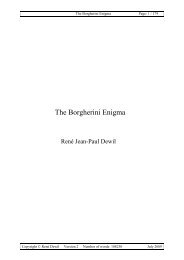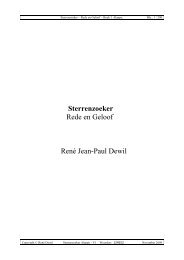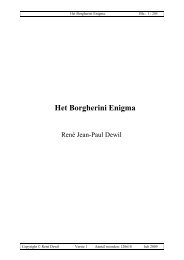A visual Journey into the Bible - Theartofpainting.be
A visual Journey into the Bible - Theartofpainting.be
A visual Journey into the Bible - Theartofpainting.be
- No tags were found...
Create successful ePaper yourself
Turn your PDF publications into a flip-book with our unique Google optimized e-Paper software.
The Deuteronomy Page: 24 / 334Bourdon remained however a Parisian painter, closely linked to <strong>the</strong> artistic sphere ofParis. In 1648 <strong>the</strong> French Royal Academy of Painting and Sculpture was founded.Bourdon was one of <strong>the</strong> twelve founding mem<strong>be</strong>rs, toge<strong>the</strong>r with o<strong>the</strong>r famous Frenchpainters such as Charles Le Brun, Eustache Le Sueur, Laurent de La Hyre, JacquesStella and Philippe de Champaigne. He even <strong>be</strong>came <strong>the</strong> Rector of <strong>the</strong> Academy ofPainting and Sculpture in 1655. Louis XIV took over <strong>the</strong> reign of France fromCardinal Mazarin in 1661. Bourdon died in Paris in 1671. The ‘Sacrifice of Jephtah’dates from around 1645, from right after his first major works that establishedBourdon’s fame in Paris. His first work in Paris to gain him renown was for <strong>the</strong>goldsmiths of Notre Dame in 1643. This commission showed some of <strong>the</strong> tendency toreconciliation of French society late in <strong>the</strong> reign of Louis XIII, as a Protestant paintercould gain such acceptance from <strong>the</strong> Roman Catholic court of France, even though<strong>the</strong>re were occasional remaining strives <strong>be</strong>tween Protestant and Catholics. CardinalRichelieu had won France for Catholicism, it was time to tolerate what remained ofProtestantism. It proves also <strong>the</strong> great admiration and appreciation of his art by <strong>the</strong>Parisian nobility and its well-to do merchant families.Sébastien Bourdon had married in 1642. He was famous, well settled. He paintedmany great paintings in this period. He was a Baroque painter, but he <strong>be</strong>longed to <strong>the</strong>French Classicist tradition of Simon Vouet (1590-1649) and Nicolas Poussin (1594-1665). Bourdon had met Poussin in Rome and seen his paintings. Laurent de La Hyre(1606-1656), Jacques Stella (1596-1657), Philippe de Champaigne (1602-1674) wereall painters in <strong>the</strong> Classicist style of <strong>the</strong> Baroque period and <strong>the</strong>ir style perfectlymatched <strong>the</strong> stern, exacting, precise spirits of <strong>the</strong> times of <strong>the</strong> Cardinals Richelieu andMazarin, who governed France. The state needed to <strong>be</strong> put to order and <strong>the</strong> Cardinalswanted logic and rigour and this naturally showed in architecture and <strong>the</strong> arts. Frenchacademism brought <strong>the</strong> rigour also in <strong>the</strong> art of painting and although SébastienBourdon’s ‘Jephtah’s Sacrifice’ dates from a few years <strong>be</strong>fore <strong>the</strong> founding of <strong>the</strong>Academy of Paris, Bourdon’s painting is an example – we would say a classicexample – of French academicism. So when you start looking at a Bourdon picture,start looking at <strong>the</strong> composition first.In <strong>the</strong> scene of ‘Jephtah’s Sacrifice’ an old temple priest leads forward Jephtah’sdaughter to <strong>the</strong> altar where she will <strong>be</strong> offered to Yahweh. Sébastien Bourdon used<strong>the</strong> left diagonal to depict an ascending line of drama. Below left, a friend of Jephtah’sdaughter kneels <strong>be</strong>fore <strong>the</strong> offering and weeps. Jephtah’s daughter looks at her fromhigher up and still fur<strong>the</strong>r along <strong>the</strong> diagonal we find <strong>the</strong> priest. Bourdon also used <strong>the</strong>right diagonal of <strong>the</strong> frame. On <strong>the</strong> lower right we find ano<strong>the</strong>r kneeling woman, amaidservant holding a silver platter with <strong>the</strong> water that cleans <strong>the</strong> offering. Thedirection of images grows <strong>the</strong>n over <strong>the</strong> head of Jephtah’s daughter to <strong>the</strong> upper leftcorner. The priest’s head lies on <strong>the</strong> left diagonal; <strong>the</strong> head of Jephtah’s daughter lieson <strong>the</strong> right diagonal. The two kneeling women, <strong>the</strong> priest and Jephtah’s daughterform a very solid triangle or pyramid, <strong>the</strong> base of which is <strong>the</strong> entire lower border of<strong>the</strong> frame. This fundamental structure – <strong>the</strong> two diagonals and <strong>the</strong> triangle <strong>be</strong>neath<strong>the</strong>m – is <strong>the</strong> very robust composition of <strong>the</strong> scene. If that structure had <strong>be</strong>en <strong>the</strong> onlyconstruction however, <strong>the</strong> composition would have suffocated <strong>the</strong> artistic and <strong>visual</strong>value of <strong>the</strong> painting. It would have <strong>be</strong>en too strong a view, too strict, too austere.Copyright: René Dewil Date: Octo<strong>be</strong>r 2001











